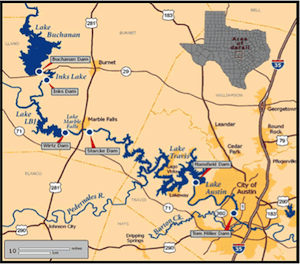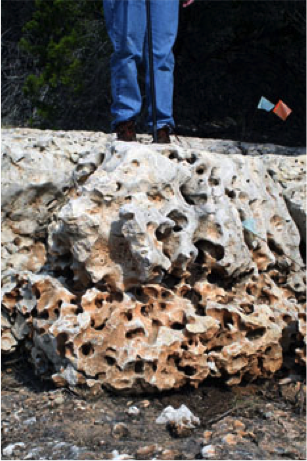With all the rain coming down the last few months, it’s an appropriate time to explore our water system. Anyone living in the central Texas region is aware of the Edwards Aquifer. Maybe you have seen “Recharge Zone” signs while driving through the hill country or you have heard newscasters refer to its levels during the drought ridden summer months, but how much do you really know about this vital part of our lives? Here is your chance to learn more about this inextricable and necessary part of our lives that we so often take for granted.
 There are 9 major and 21 minor aquifers in Texas that supply 59% of the water used in the state. Since we are based in Austin, Edwards Aquifer most relevant to us. The Edwards Aquifer is made up of porous limestone with areas of such high permeability. It allows for the transmission of large volumes of water, enabling groundwater levels to respond quickly to rainfall (recharge) events. This is beneficial to those to depend in the aquifer because it means that even small amounts of rain will improve aquifer conditions. This is not to say that all of the water in the aquifer was deposited recently, some of the water being used today likely went underground around the time that Texas was struggling to gain independence from Mexico. Still, compared to other less permeable aquifers even that is not a very long time ago – water in the Ogallala Aquifer dates back to the most recent ice age, approximately 11 to 12 thousand years ago.
There are 9 major and 21 minor aquifers in Texas that supply 59% of the water used in the state. Since we are based in Austin, Edwards Aquifer most relevant to us. The Edwards Aquifer is made up of porous limestone with areas of such high permeability. It allows for the transmission of large volumes of water, enabling groundwater levels to respond quickly to rainfall (recharge) events. This is beneficial to those to depend in the aquifer because it means that even small amounts of rain will improve aquifer conditions. This is not to say that all of the water in the aquifer was deposited recently, some of the water being used today likely went underground around the time that Texas was struggling to gain independence from Mexico. Still, compared to other less permeable aquifers even that is not a very long time ago – water in the Ogallala Aquifer dates back to the most recent ice age, approximately 11 to 12 thousand years ago.
Long periods of time without precipitation have especially detrimental consequences on the aquifer. The current drought has been ranked as one of the 10 worst in 500 years. Drought alone, while serious, is not out of the ordinary for the region; the story of Texas is one of drought and recovery. Similar droughts occurred in the 1880s and in the 1950s. 
It may seem puzzling that we receive rainfall and have even experienced flooding in this drought. We have experience rain, but not under the right conditions. The timing of storms in the Hill Country allowed the soil to dry out between rain events, which resulted in little runoff into the lakes. For water to flow into the lakes, the rain must fall on saturated ground, or the rain must be hard enough to generate substantial runoff. Neither of which has happened to the extent necessary.
The large population boom to Texas puts pressure on Central Texas’s two primary sources of water: the Highland Lakes and Edwards Aquifer. While we can’t make water appear from thin air, we can enact policy that will conserve and protect the water that we do have. The Lane City Reservoir, to be completed in 2017, is the first project that will allow LCRA to capture and store significant amounts of water downstream of the Highland Lakes. The reservoir could add up to 90,000 acre-feet per year to LCRA’s firm water supply.
In recent years many innovation have been made to improve water use. For example, 60% of the state’s water goes to agriculture. In the past few years, drought stricken areas have taken to recycling wastewater for use in irrigation. Aquaponics is a growing industry that is replacing the convention and inefficient drip-irrigation systems in many places. Powerplants are another large source of water consumption. It’s possible that a future with a greater reliance on solar and wind power could alleviate that pressure. Cities like Los Angles are also engineering their infrastructure to get the most out of every drop of water. So while a future with water shortages may be unavoidable, education and proper planning can make the future a little less bleak.
Interested learning more about the Edwards Aquifer? Here is a informative video that quickly shows how water travels through the Edwards Aquifer:
Sara Dunlap
GIS Analyst
sdunlap@banksinfo.com
Sources:
https://www.lib.utexas.edu/geo/fieldguides/physiography_print.html
http://www.edwardsaquifer.net/geology.html
http://www.twdb.state.tx.us/groundwater/aquifer/
http://www.mysanantonio.com/news/environment/article/A-trip-into-the-Edwards-Aquifer-4592658.php#photo-4767394
http://stateimpact.npr.org/texas/2011/11/15/five-things-you-didnt-know-about-water-in-texas/
http://www.lcra.org/water/water-supply/drought-update/Pages/default.aspx
